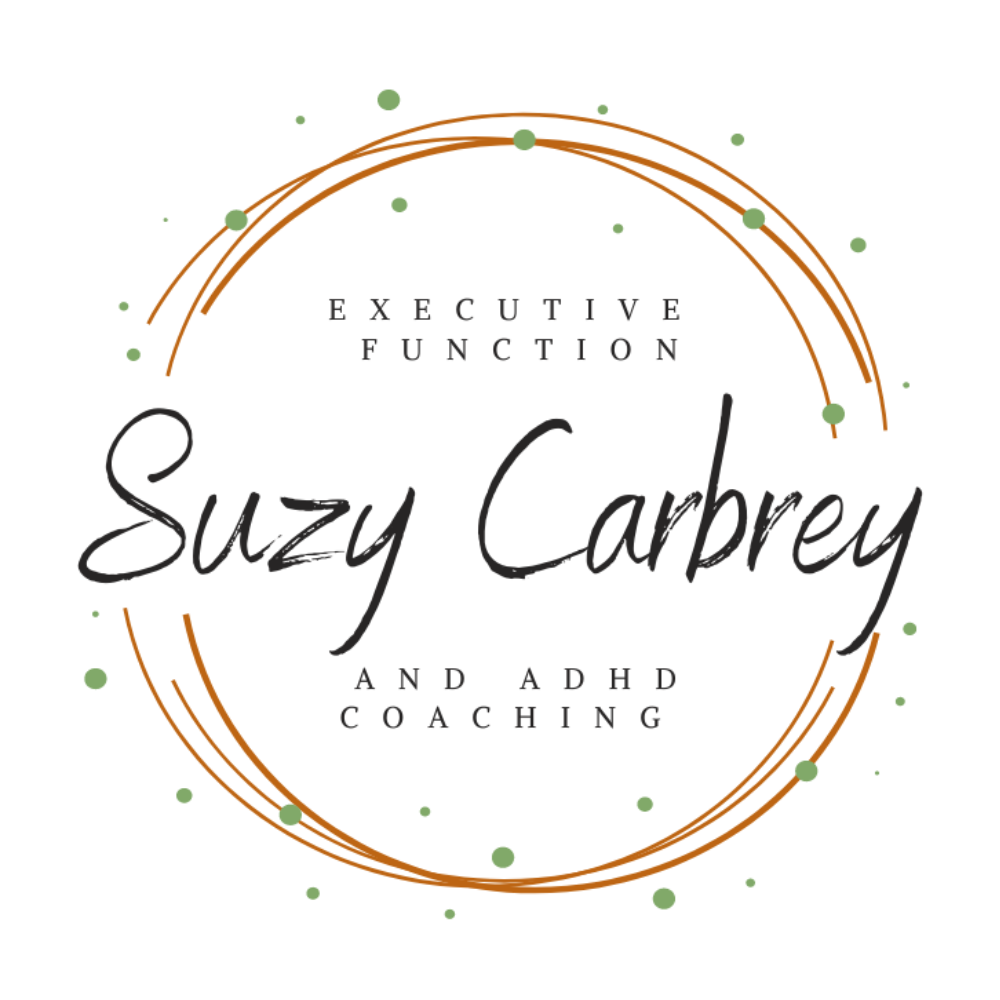Written by Suzy Carbrey ⧫
Supercharge Your Executive Functioning and Thrive With ADHD: Harnessing the Power of Sensory Processing
Welcome to this blog post, where we will delve into Winnie Dunn’s Model of Sensory Processing and its relevance in enhancing executive functioning and managing ADHD in adults.
Winnie Dunn is an occupational therapist and researcher known for her work in the field of sensory processing. Dunn developed the widely recognized Model of Sensory Processing, which outlines four primary patterns of sensory processing: Seeker, Avoider, Sensor, and Bystander. Her research has significantly contributed to understanding how sensory processing affects individuals’ daily lives and how interventions can be tailored to address sensory challenges. Winnie Dunn’s work has been influential in the fields of occupational therapy, child development, and neurodiversity.
What is Sensory Processing?
Sensory processing means how our body and brain work together to understand the information we get from our senses. We have five main senses: touch, sight, hearing, taste, and smell. When we touch something, see something, or hear a sound, our body sends messages to our brains to help us make sense of what’s happening around us.
Everyone’s brain processes sensory information a little differently. Some people might be more sensitive to certain sensations, like loud noises or bright lights, while others might not notice them as much. Some people might really like certain sensations and seek them out, like spinning in circles or touching different textures.
Understanding sensory processing is important because it helps us understand how we react to different things in our environment. It can affect how we pay attention, how we feel, and how we behave. By learning about our own sensory preferences, we can find ways to manage things that bother us or make us feel overwhelmed. It’s all about understanding how our senses work and finding what helps us feel comfortable and focused.
Cracking the Code: Why Sensory Processing Matters for People with ADHD
Sensory processing is very important for people with ADHD because it affects how they pay attention, control their feelings, and behave. Here are a few reasons why it’s so important:
Sensory Sensitivities
Some people with ADHD are extra sensitive to certain things, like loud noises or bright lights. These things can make it hard for them to concentrate and stay focused. Understanding and dealing with these sensitivities can help them do their best.
Hyperactivity and Impulsivity
Sometimes, people with ADHD feel the need to move around a lot or do things without thinking first. This can be because they need extra sensory input. By finding ways to meet these sensory needs in appropriate ways, they can be less hyperactive and impulsive.
Handling Emotions
Sensory processing can affect how we feel. For people with ADHD, overwhelming sensory experiences can make them feel frustrated, angry, or worried. Understanding their sensory patterns helps them find ways to handle these feelings better.
Getting Things Done
Sensory distractions can make it tough for people with ADHD to get things done and stay organized. They may struggle with planning, managing time, and following through on tasks. Using sensory strategies can make it easier for them to stay on track and be more productive.
Knowing Themselves Better
Understanding sensory processing helps people with ADHD know what they need to feel their best. They can speak up for themselves and ask for support or changes that help them handle their ADHD symptoms. This self-awareness gives them more control over their lives.
By considering sensory processing and finding ways to deal with sensory needs, people with ADHD can do better overall. They can pay attention more, control their impulses, manage their emotions, get things done, and speak up for themselves. Everyone’s sensory processing is unique, so finding personalized strategies that work for each person is key to managing ADHD effectively.
The Four Patterns of Sensory Processing
 By learning about Winnie Dunn’s four patterns of sensory processing – Seeker, Avoider, Sensor, and Bystander – people can make their daily experiences better and find ways to control their feelings and actions. Let’s look at each pattern and see how it can help adults with challenges in how they think and focus.
By learning about Winnie Dunn’s four patterns of sensory processing – Seeker, Avoider, Sensor, and Bystander – people can make their daily experiences better and find ways to control their feelings and actions. Let’s look at each pattern and see how it can help adults with challenges in how they think and focus.
1. The Seeker
Seekers are individuals who actively seek out sensory experiences that provide them with a high level of input. They may engage in behaviors like tapping their feet, fidgeting, or consistently seeking out novel experiences. This pattern can be observed in adults with conditions like ADHD, as they require heightened sensory stimulation to maintain focus. Identifying this pattern allows us to integrate activities rich in sensory input into their daily routines. This approach facilitates improved attention and heightened alertness.
2. The Avoider:
Avoiders are individuals who exhibit an aversion to specific sensory stimuli and actively attempt to avoid such experiences. This can encompass dislikes for loud noises, intense lights, or tactile sensations like rough fabrics. Adults who struggle with cognitive and attentional functions may find busy environments overwhelming due to their heightened sensitivities. Recognizing being an avoider allows them to modify their surroundings to reduce overwhelming sensory stimuli, ultimately diminishing stress levels and enhancing their capacity to concentrate.
3. The Sensor:
Sensors are people who are not too eager for lots of sensory input, and they don’t shy away from it either. But in this group, some might get overwhelmed. These overwhelmed Sensors have a lower tolerance for sensory things, like sounds or textures. They tend to let things happen around them without reacting much, which can lead to feeling overwhelmed by too much sensory stuff. This is important for adults dealing with thinking and focus challenges. By knowing about this possibility in the Sensor group, we can help them learn how to handle their surroundings better. At the same time, we can help them strengthen their thinking skills and learn to control their reactions, which makes their overall life better.
4. The Bystander:
Bystanders are people who don’t have strong reactions to sensory input. They just observe and respond calmly. This pattern is not as distinct as the others, but adults with thinking and focusing challenges might also show this pattern. Recognizing the Bystander pattern encourages them to find a balanced approach to sensory processing. It also helps them focus on strategies that improve their thinking skills and ability to control their actions.
By knowing and understanding these patterns, adults can improve how they think and focus. They can find activities that help them concentrate, create environments that minimize sensory distractions, use strategies that enhance their thinking skills, and find a balance in how they respond to sensory input.
Improving Executive Functioning and ADHD through Sensory Processing
When we understand Winnie Dunn’s Model of Sensory Processing and the patterns it includes, it can really help adults with executive functioning and ADHD. Here are some ways to use this knowledge:
Change the Environment
Make the surroundings more sensory-friendly by reducing distractions, using things like special headphones, or adjusting the lights. Calming items like fidget toys or stress balls can also be helpful, depending on each person’s pattern.
Take Sensory Breaks
Throughout the day, take short breaks to do activities that help you relax and concentrate. This can include stretching, deep breathing exercises, or listening to calming music. It all depends on your own sensory pattern.
Personalized Sensory Diets
Create a plan of activities that are just right for your sensory pattern. This can include movement breaks, tactile stimulation (like touching different textures), or using special sensory tools such as weighted blankets or sensory-friendly office supplies.
Manage Time Better
Use visual schedules, timers, or digital reminders to help with managing time, staying organized, and deciding what to do first. Take into account your own sensory pattern when using these strategies.
Practice Mindfulness and Self-Regulation
Try exercises like mindfulness, meditation, or yoga to help control your emotions, reduce stress, and feel better overall. Adapt these techniques to fit your sensory pattern.
Unleash Your Potential: Harnessing Sensory Processing for Improved Functioning with ADHD
 Discovering how sensory processing can benefit individuals with ADHD is just the first step. Now, let’s explore how someone with ADHD can use this knowledge to experiment and find strategies that work best for them, promoting improved functioning and well-being. By maintaining consistency while being flexible in the process, individuals can unlock their potential and thrive with ADHD.
Discovering how sensory processing can benefit individuals with ADHD is just the first step. Now, let’s explore how someone with ADHD can use this knowledge to experiment and find strategies that work best for them, promoting improved functioning and well-being. By maintaining consistency while being flexible in the process, individuals can unlock their potential and thrive with ADHD.
Understanding Your Sensory Patterns
Begin by identifying your sensory patterns (Seeker, Avoider, Sensor, or Bystander) using Winnie Dunn’s Model of Sensory Processing. Observe how different sensory experiences affect your attention, emotions, and behavior. Recognizing your patterns will guide you in developing effective strategies.
Experimentation and Self-Awareness
Try different strategies aligned with your sensory pattern to see how they impact your functioning. For Seekers, engage in sensory-rich activities like fidget toys or movement breaks. Avoiders should create a sensory-friendly environment with minimal distractions. Sensors can focus on executive functioning strategies while considering their sensory needs. Bystanders should aim for a balanced approach to sensory processing. Take note of what works best for you.
Consistency and Flexibility
Consistency is key in implementing strategies. Establish routines and incorporate sensory-based activities into your daily life. However, be open to adapting and refining your strategies as needed. Each person’s journey is unique, so remain flexible and willing to make adjustments based on your experiences and feedback.
Self-Reflection and Adjustments
Regularly reflect on how the strategies are impacting your functioning. Keep a journal to record your observations and insights. Ask yourself questions: What activities help you focus better? Which strategies alleviate stress or sensory overload? Make adjustments based on your findings to fine-tune your approach.
Seek Support
Reach out to professionals, such as occupational therapists or ADHD coaches, who can provide guidance tailored to your specific needs. They can help you further explore sensory processing strategies and assist in finding personalized solutions for your challenges.
Unleash the Full Potential of Sensory Processing in ADHD
 In conclusion, understanding Winnie Dunn’s Model of Sensory Processing and its patterns – Seeker, Avoider, Sensor, and Bystander – provides valuable insights for improving how adults with ADHD think and cope. By recognizing and respecting our unique sensory patterns, we can employ targeted strategies that support our sensory needs, enhance focus, and nurture emotional well-being. When we harness the power of sensory processing and actively experiment with strategies, we unlock our potential for better functioning. Consistency in implementing strategies, flexibility in adapting approaches, self-reflection, and seeking support are crucial on this journey. Embracing the process, staying open to exploration, and discovering what works best for us are keys to thriving and unleashing our true potential with ADHD. With determination and self-awareness, we can navigate our path to success.
In conclusion, understanding Winnie Dunn’s Model of Sensory Processing and its patterns – Seeker, Avoider, Sensor, and Bystander – provides valuable insights for improving how adults with ADHD think and cope. By recognizing and respecting our unique sensory patterns, we can employ targeted strategies that support our sensory needs, enhance focus, and nurture emotional well-being. When we harness the power of sensory processing and actively experiment with strategies, we unlock our potential for better functioning. Consistency in implementing strategies, flexibility in adapting approaches, self-reflection, and seeking support are crucial on this journey. Embracing the process, staying open to exploration, and discovering what works best for us are keys to thriving and unleashing our true potential with ADHD. With determination and self-awareness, we can navigate our path to success.
Begin Online Coaching for Executive Functioning / ADHD
Ready to gain control and enhance your executive functioning? As an experienced and compassionate coach, I specialize in providing support for executive functioning and ADHD. To embark on your journey, please reach out to me at 708-264-2899 or email hello@suzycarbrey.com to schedule a FREE 20-minute discovery call consultation.
With a background as a speech-language pathologist, I have a strong foundation in executive functioning coaching. My graduate degree program in SLP placed a significant emphasis on cognition, including executive functions, and I have years of experience in medical rehabilitation, providing cognitive-communication therapy. Additionally, I have completed an ADHD Services Provider certification program, I am Solutions-Focused Brief Therapy Diamond Level 1 certified and I am trained in the Seeing My Time® executive functioning curriculum.
Experience the convenience and effectiveness of online coaching, backed by studies that demonstrate equal results to in-person services. Parents, professionals, and emerging adults love the convenience and privacy of receiving coaching from their own homes.
Whether you reside in Chicago, Milwaukee, Indianapolis, Kansas City, or anywhere else around the globe, I am here to assist you. Schedule your discovery call consultation today, and I eagerly anticipate the opportunity to work with you!
Please note that although I am a certified speech-language pathologist, all services Suzy Carbrey LLC provides are strictly coaching and do not involve clinical evaluation or treatment services. If you require a formal speech therapy evaluation and treatment, please inform me, and I can provide appropriate recommendations.

